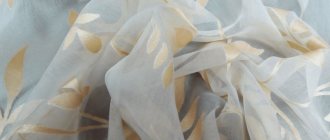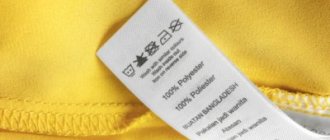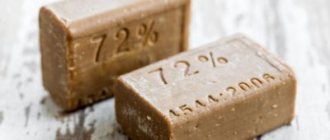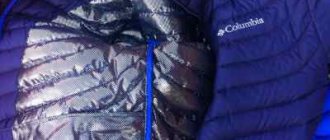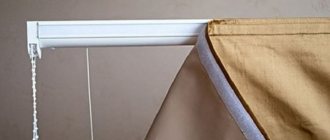Curtains with eyelets can become a real decoration of a room, so many people order such products for themselves without thinking about how to wash them.
When this moment does come, curtain owners have a lot of questions.
You can wash curtains with eyelets in a washing machine or by hand, but you need to do it correctly. For more information on how to wash curtains with eyelets, read the article.
Practical advice
Depending on the type of eyelets, the following must be considered:
- Eyelets made of wood deteriorate under the influence of water. Such products must be washed by hand, without lowering the upper edge where the fittings are located into water;
- Metal eyelets also do not tolerate water, which can quickly cause them to become rusty. It is better to minimize contact with water;
- eyelets made of plastic are more practical than those made of other materials, but if the plastic is of poor quality and there is paint on it, it may come off from water.
Note that:
- Curtains should be washed separately from other linen and items.
- Washing powder may leave white stains on the fabric; it is better to use a gentle product, such as shampoo or shower gel.
- If there are snags or holes in the material, or if the fittings jump out of the straps, then the curtains will be damaged when washed in the machine.
- If the product is made to order, then you need to immediately ask the tailor about the rules for caring for the material, because there will be no standard tag on the product.
- When washing mechanically, the drum of the washing machine must be designed to hold a lot of weight so that the curtains rotate freely.
- After washing, you need to immediately remove them from the machine drum so that the rings do not oxidize.
- Curtains with dirty stains should be soaked in soapy water before washing; substances with chlorine should not be used; if necessary, it is better to use a more gentle stain remover.
- If you don’t know what material you are dealing with, it is better to use dry cleaning services.
- If curtains made of threads do not have decorative beads and rhinestones, they can be machine washed on automatic mode, having previously been tied with knots.
- You don’t have to bother with washing and ironing, but clean it using a steam cleaner.
Why you need to think about the quality of eyelets
It is convenient when the rings are removable - this greatly simplifies the process of caring for curtains. If the eyelets are not removable, then the method of cleaning will depend on the material from which they are made.
High-quality metal rings will not create any problems for you. You can safely wash the curtains - neither the fabric nor the fittings will be damaged. However, if the eyelets are made of low-quality metal, then during washing they can oxidize and rust, leaving a mark on the curtains that is difficult to remove.
You also need to be careful with plastic rings. Eyelets made from cheap plastic may break during washing or lose their attractive appearance.
If you doubt the quality of the eyelets, we advise you to avoid wet processing of curtains. You can locally wash heavily soiled areas of curtains. In other cases, it is better to use dry cleaning methods.
Home washing
Read the information on the tag, determine the type of material. If the manufacturer allows you to use a washing machine, select the appropriate wash cycle. The curtains are placed in a protective washing bag; if you don’t have one, you can use a pillowcase.
For hand washing, the detergent is diluted in water at 40 degrees. Bulk products are best placed in the bath. They are left to soak for a couple of hours, then thoroughly rinsed in fresh water several times. During the washing process, there is no need to bother with friction and twisting of the fabric.
Types of eyelets
Grommets are a type of fitting used to attach curtains to a curtain rod. Initially, they were made in the form of rings, but modern designers are coming up with unusual figured eyelets.
eyelets
Using these devices, the edges of holes in the fabric are strengthened. At the same time, perfect folds are formed on the curtains. Eyelets are made from materials such as:
- metal;
- plastic;
- tree.
Over time, steel fasteners lose their attractiveness due to water and aggressive detergent components. Rusted or peeling eyelets can ruin the fabric.
Plastic fittings are more affordable. It creates less noise when in contact with the cornice. Such eyelets are unpretentious in care; curtains on them can be safely soaked and washed.
Some manufacturers use a cheap version of plastic and apply paint to its surface. Such products can quickly lose their appearance.
The most impractical are wooden eyelets. The material is environmentally friendly, but does not withstand exposure to water at all. Such curtains are washed exclusively by hand, being careful not to wet the fabric around the fastenings.
Eyelets are used when sewing curtains from different types of fabric, even from very thin and light material. In such cases, fasteners are sewn into an additional insert made of dense material.
Expert opinion
Irina. Housewife.
Ask a Question
The main advantage of using eyelets is reliability. Such curtains cannot be torn off, even if you make an effort.
Thanks to evenly distributed fastenings, perfect symmetrical waves appear on the curtain fabric, which look very elegant.
shtorasvetlana
vintage_home51
prestigdekor
skorohod22
Drying
Curtains with eyelets should be dried naturally. After wrung out a little, the curtains are hung out to dry; under the mass of absorbed water they will straighten themselves, which will make the ironing process easier or even eliminate the use of an iron. When drying, it is better to avoid direct sunlight, as ultraviolet rays can disturb the texture of the fabric and it will change its appearance. You can iron them when they are completely dry.
Some fabrics need to be dried in a horizontal position, for example, velvet, otherwise it will stretch, this rule applies to any stretchy or heavy material.
Alternative Cleaning Methods
The less often the product comes into contact with water, the longer it will last . However, this does not mean that you should leave your curtains dirty.
There are several ways to clean them without removing them from the curtain rod. Among them:
- Vacuum cleaning . The device allows you to get rid of accumulated dust.
- Cleaning with a steam generator . With its help, you can carry out wet treatment of curtains, but without the use of detergents.
- Washing with a sponge and detergent . In this way, you can get rid of spot dirt and single stains.
Another way to carefully wash your curtains is to entrust their care to professionals.
Dry cleaning includes products made from delicate fabrics or massive fabrics, which are problematic to wash at home. The average cost of washing curtains with eyelets is 500 rubles.
Washing rules for different types of fabrics
Curtains and curtains with fittings are varied. To ensure that washing does not turn out to be critical, you need to take into account not only the presence of eyelets, but also the type of fabric.
Natural materials
Linen is cleaned by delicate washing. To remove stains, the fabric is pre-impregnated with a chlorine-free product. Wash in warm water without spinning. Ironing should be done at high temperature.
Washing machines have their own mode for cotton; the water temperature should be 60 degrees. Ironing with steam.
Delicate materials
Organza is usually soaked in cold water. Be sure to wash in a protective bag. After washing, the curtains are immediately hung on the curtain rod and do not require ironing.
Silk and taffeta are not soaked; they are washed on a delicate cycle without spinning. Washed items made from these materials are placed vertically so that they straighten under the weight of water. If the fabric is not smooth enough, you can iron it inside out with gauze.
Viscose and acrylic are washed in gentle settings, without spinning. To soften the fabric, use conditioner. Ironing is carried out through gauze, with an iron at medium temperature.
Before machine washing, fold the velvet inside out and select the delicate setting. When drying, the fabric should be placed horizontally.
Under the influence of external factors, nylon becomes yellow or gray; to return the white color, after delicate washing, the curtains need to be soaked for a couple of hours in water with dissolved salt. Curtains made of wool and chintz are washed only by hand in low-temperature water.
Manually
Massive curtains are most conveniently washed in the bathroom. Small thin curtains can be placed in a basin.
Manual processing instructions:
clean the product from dust and other contaminants;- pour water into a suitable container, its temperature should be 40 degrees;
- dissolve detergent in water;
- soak the curtains for 15 minutes;
- carefully deal with all contaminants that require mechanical cleaning;
- Rinse thoroughly in running warm water until the foam is completely washed away.
The curtains should not be wrung out. The water must be allowed to drain, after which the product is hung on the ledge.
conclusions
Curtains and drapes with eyelets are easy to use, as can be seen from reviews, they are easy to remove and hang on a curtain rod, moreover, they decorate the interior favorably and fit any style.
First of all, dust settles on the curtains, this is especially problematic if the windows face the active side of the street. To avoid the appearance of dust parasites and simply an untidy appearance, the curtains must be looked after - washed, dry or steam cleaned. Curtains with eyelets are no exception and require appropriate care.
Can curtains with eyelets be washed? Yes, you can, but in compliance with the manufacturers’ recommendations and practical advice from specialists. Caring for such products is not a problem and in many cases you can do it yourself.
When choosing curtains with eyelets, you need to refrain from saving money and choose high-quality products so that after every wash and cleaning they look like new.
How to dry the curtains then?
There are several ways to dry curtains with grommets. The easiest way is to hang them on a curtain rod immediately after washing. Then they will “sag” and ironing will not be required. However, not all types of fabrics can be dried this way. For example, velvet is laid out on a horizontal surface with a terry towel underneath and left until completely dry. If you hang such curtains wet, they will stretch. Be careful, it is better to dry heavy or stretchable curtains horizontally.
We recommend: Is it possible to wash red items with black and dark ones - is there a risk?
Curtains with eyelets are a very convenient model. They always lie in beautiful folds, are easily removed from the cornice, and the fittings act as a stylish decorative element. And by and large, washing them is not that difficult. All you need is to purchase a delicate wash bag, set the correct cycle and use liquid powder. Well, if the fabric is very delicate, for example velvet or flock, or the eyelets are made of wood, then the curtains will have to be washed by hand or used for steam cleaning.
Correct ironing
Crumpled curtains will ruin any interior. It is better to iron them freshly washed and damp. If the dried canvas lies for some time, difficult to smooth out wrinkles may appear on it.
It is important to make sure that the soleplate of the iron is clean. Having melted from the high temperature, small fibers will stick to the fabric.
The ironing mode should be selected according to the type of material or according to the information on the product tag. Thin and delicate curtains made of chiffon, organza, and silk require special delicacy. In order not to spoil them, you should try ironing a spare piece of fabric or a corner of the linen.
So, in order to iron the product efficiently and without damage, do the following:
- place several chairs near the ironing board to make it easier to work with large fabrics;
- start with the areas of fabric around the eyelets;
- then carefully move along the curtain from top to bottom.
Modern irons and steam generators make ironing large curtains much easier. At the same time, the likelihood of sticking is minimal due to the special coating of the sole.
A vertical steamer simplifies and speeds up the process. It is enough to walk it over the surface of the curtains hanging on the windows.
How to calculate the location of eyelets on a curtain
Since the curtain must have the correct direction of folds on both sides, the number of eyelets on it must be even. This is the first rule. Second, do not make the distance from the edge to the center of the outer eyelets too large, otherwise the edge of the curtain will simply “hang down”. It also depends on the density of the fabric itself and the type of treatment on the top of the curtain. But in any case, 5 cm will be quite enough, plus or minus a centimeter.
Approximately the same applies to the top, 3-4 cm is quite enough. Otherwise, the top part of the curtain will “fall” like a chicken’s comb, which will ruin not only your work, but also your mood, and for a long time. As for the location of the eyelets in relation to each other. Choose it yourself, but without going beyond the recommendations indicated in the diagram and photo. The greater the distance between the eyelets, the deeper the folds should be. But you need to take into account the texture of the fabric and the method of strengthening the upper part of the curtain. On adhesive fabric or on a special curtain tape (for attaching eyelets). You also need to take into account the length of the curtain itself. Agree, a short curtain reaching to the window sill with large folds and vice versa will look ridiculous. A long curtain 3 meters high, folded in a small fold. Experiment, add folds with clothespins and secure them to the cornice. Perhaps even a distance between grommets of 20 cm will be small for your curtain.
Installing eyelets using duplicating fabric
You don’t have to buy liver tape if you decide to save money. To do this, you can make a large turn of the fabric at the top of the curtain (to the size of the outer diameter of the eyelet, plus other allowances) and duplicate this area. You can duplicate with adhesive fabric or thick fabric. Or both together. But be sure to tape the holes on the wrong side of the curtain fabric before cutting them out. And be sure to reinforce these areas with pins so that after installing the eyelets, the upper part of the curtain does not have any shifts or folds. Don't forget about the iron, iron this area well.
Typical thick curtains
Cotton, linen
Curtains made from these real fabrics are extremely durable, so they can be safely machine washed at 40°C.
For cotton, you can use any powder; for linen, a liquid detergent for washing thin fabrics is better. Undyed flax is not afraid of boiling, so in case of heavy contamination, the temperature can be increased
When loading linen products, it is important not to put too many of them so that there is no loss of water and they are washed and rinsed perfectly. The washing mode must be set to “for delicate fabrics” or “hand wash”
It is better to turn off the spin to make ironing easier later. After the cycle is completed, allow the water to drain. Such curtains are dried at a temperature of 20 degrees, away from radiators. It is easier to iron them slightly damp with a hot iron on the appropriate setting - “cotton” or “linen”.
It would be a good idea to wash curtains made of chintz - a thin cotton weave - only by hand, after soaking them for an hour or two in advance. This is a delicate fabric and can be damaged if rubbed or twisted too hard.
Polyester and polyacrylic are easy to wash both by hand and in a machine. The water temperature should be around 40 °C. The number of revolutions can be made smaller or simply set to “silk” mode
This will prevent wrinkles and creases from occurring.
It is important to rinse well. You can dry it by hanging it vertically, away from radiators and the penetration of the sun's rays.
Viscose or acetate curtains lose their stability and elasticity when wet, so they must be handled with care.
- It is better to put them in a laundry bag; if this is not the case, then use a pillowcase. So they don't change.
- Select “silk” or “hand wash” mode.
- Use detergent for delicate fabrics.
- The water should not be more than 30 °C.
- Turn off the automatic spin or reduce the speed.
- Allow the water to drain and lay it out on a flat surface, placing it under soft, clean material.
- Iron at 150°C.
Before putting them in the washing machine, velvet curtains are rolled inside out into a long strip, the width of which is equal to the depth of the drum. Then they roll it into a cylinder and place it in the middle. This way they do not change and the pile cannot be harmed.
- The washing time is set to short, “silk” mode.
- The water temperature should not exceed 30 °C.
- You cannot squeeze or twist.
- Velvet should be dried in a straightened state on a surface placed horizontally, face up.
Thin and translucent fabrics made from real or artificial raw materials require especially careful care.
Silk, chiffon, organza, veil
All these fabrics are very delicate and thin. The optimal method is a variety with soaking and repeated changes of water. However, if you still want to deal with them faster, then you just need to carefully put them in a specialized washing bag and wash them in a machine on the appropriate mode at a water temperature of 30 °C. In this case, soaking is not necessary, since dirt can be removed from them quite simply.
- Use a minimal amount of liquid powder or gel.
- You can't push it.
- Only real silk will require ironing; organza and veil can simply be hung on the curtain rods, and they will straighten out on their own.
This is interesting: How to wash silk - 5 tips before washing, choosing a method and product
What to do if you sit down?
If the curtains shrink after washing, you can take the following actions:
- Open the bottom hem. On many products it is wide enough, so it allows you to hide shrinkage of 2 cm.
- Increase the length of the curtains with fringe, which is sewn at the bottom.
- Buy hooks that will be longer.
- Move the ceiling cornice.
On the Internet you can find various solutions to the problem. Sometimes it is recommended to stretch curtains using a steam iron. Some users recommend wetting the product and increasing its length mechanically.
All these methods are irrational, since it will not be possible to achieve uniform tension, but it is quite possible to spoil the product in this way. Therefore, it is easier to prevent a problem than to spend energy and money on eliminating it later.
How to install eyelets on tape
You can buy special grommet tape in curtain fittings stores. Install one part of the grommet on it, and then make markings on the curtain fabric. Sew the tape along the edges, cut a hole in the curtain and snap the second (front) part of the eyelet. That's it, you can hang the curtain on the curtain rod. There is a tape that you need to glue with a hot iron to the curtain fabric, and then cut holes and install grommets. By the way, the eyelet tape can be inserted into a pre-prepared wide hem. Choose for yourself which method suits you best.
But you definitely need to carefully cut the holes, preferably with an allowance of 1.5-2mm, that is, the diameter should be smaller. If you do not glue the tape with an iron, it is still better to glue at least the section of the curtain where the hole will be cut with a thin adhesive fabric. In any case, you should first try it on a piece of fabric before you start putting eyelets on the finished curtain.
To remove or not to remove eyelets?
Many housewives worry about whether the eyelets themselves will be damaged during washing and whether they will leave rusty stains on the fabric. It is impossible to give clear recommendations here. Typically, manufacturers make these decorative elements from metal that can withstand exposure to water and does not corrode. But if there are doubts about the quality, you can remove the eyelets yourself before washing: just insert a thin object (a metal ruler or a knife) between the halves and pry one half off.
Removed eyelets can be easily put back in place after washing by placing them on both sides of the hole and squeezing until they click. There is no need to worry that the edges of the holes under the eyelets will stretch or creep away - when making such products, the holes are sealed with a special device.
How to wash tulle so that it is white?
White cotton or linen fabric can be bleached using ammonia and hydrogen peroxide.
- Add a tablespoon of peroxide and the same amount of ammonia to a ten-liter container of hot water (approximately 65 degrees).
- Stir and soak the curtains in the solution.
- After an hour, wash
and dry.
Interesting materials:
Why don't cucumber seeds germinate when soaked? Why don't cucumber seeds germinate? Why don't the iris buds bloom? Why don't chrysanthemum buds bloom? Why won't music download to my iPhone? Why can't I download applications from the Internet? Why don't peppers ripen? Why don't chrysanthemums have time to bloom? Why can't I see Bluetooth on my iPhone? Why doesn't it see Bluetooth?
Manual method
Helpful Tips:
- Prepare a bath or large basin. Pour water (+30 °C or lower). Add detergent (it is better to choose gel). It dissolves quickly in water. For this, 1 tbsp. l. diluted in 3 liters of water.
- The curtains are placed in the liquid, soaking for 15-20 minutes. If there are eyelets, they are hung over the edge. If there are stainless steel elements, all parts are immersed in water
- Don't rub too hard. Use gentle movements to clean all sections of the curtain.
- You need to rinse the fabric at least 4 times in clean water so that all the soap solution is removed. This is evidenced by the absence of bubbles in the water.
Wring out the fabric, hang it on the dryer or directly on the curtain.
How and when to hang up clean curtains?
1. We hang clean curtains in a damp state on the cornice. When threading the first grommet, make sure that the edge of the curtain is directed towards the wall and not into the room.
2. After this, screw back the tip and bolt to secure the pipe. We unfold the latter so that the bolt from the tip is not visible.
3. Immediately give the curtains the desired look by forming folds.
Tip: even if the curtains look wrinkled, hang them on the curtain rod while damp. After the product has dried, it can be removed and ironed. Drying on ropes, dryers and pipes will leave creases on the product that will be quite difficult to iron. Among other things, drying such a large product on a horizontal surface is quite problematic, especially in a small apartment.
Preparation
Before you start washing the curtains, you need to remove them from the curtain rod, but before doing this, thoroughly vacuum them along their entire length using a soft-bristle nozzle. Thanks to the suction power of the home “cleaner”, the fabric fibers will be freed from a large amount of dust, and subsequent washing will be much easier and more efficient.
It is not advisable to use powder detergents to wash curtains. They do not dissolve well even in hot water: grains still remain that can get stuck between the fibers of delicate fabric and ruin its appearance. In addition, when washing with powders, unattractive stains often remain after the product dries.
The best option for curtains with eyelets is to use liquid detergents: gels, liquids, capsules. They gently act on any type of material, dissolve in water without residue, effectively remove particles of dust and dirt and are completely rinsed without leaving streaks on the surface of the product, be it organza, nylon or brocade.
Washing curtains is exactly the case when you should not save on buying detergents, because the quality of washing and the appearance of the product directly depend on their characteristics. You should also purchase or sew a special bag for washing delicate items. It must be proportionate to the curtain, otherwise the result will be exactly the opposite. That is, the curtain inside the bag should lie freely when folded. The bag is also needed to protect the machine - if some eyelet suddenly comes unfastened, it will remain inside the bag and will not be scratched or damage the drum.
If you don’t have such a bag at hand and it’s time for washing, you can use an old pillowcase of a suitable size. After placing the curtain in it, the upper open edge of the pillowcase must be gathered and tied tightly with a lace or braid. An improvised bag, lace or braid should not fade, otherwise you can ruin an expensive curtain.
How to machine wash tulle: basic principles
To achieve the maximum effect from washing, handle tulle with care, following some rules:
- Before putting it into the machine, soak the tulle in cool water to remove any accumulated dust.
- Place the fabric in the drum of the machine in a straightened, even form, without crumpling. This will avoid wrinkles and do without further ironing of some types of tulle.
- Mesh fabrics, especially muslin, should be placed in a special bag before washing, which prevents accidental snagging and deformation of the fibers.
- Set the spin cycle to minimum speed (400-500) or do without it at all.
- Use soft detergents: gels, conditioners, starching and bluing solutions.
At what temperature should you wash tulle?
The optimal water temperatures at which it is recommended to wash tulle in a washing machine are low and medium.
The washing temperature should be set within 30-40 ℃
Temperatures above 50 degrees are only permissible when you are going to wash tulle made from mixed fabrics (cotton and polyester). White curtains made of organza, nylon or veil will quickly turn yellow and fray from hot water.
What mode should you use to wash tulle?
For washing delicate fabrics, the delicate cycle is preferable. Since tulle tolerates soaking well, the washing and rinsing time can not be limited.
In addition to setting the delicate wash cycle, set the spin speed to minimum and select the extra water or double rinse function.
Removing complex stains
In some situations it is impossible to do without additional measures. If there are greasy stains on the tulle, which often appear on kitchen curtains, or yellowing appears, stronger products will be required. They must be applied before putting the tulle in the washing machine.
Pre-soaking in solutions of soda or salt works well to remove ingrained dusty grayness and light yellowness from tulle. The solution needs to be fairly concentrated: 1 tbsp. l. for 1 liter of water. It is prepared in a large container and the curtains removed from the windows are immersed in it. Soaking time is not limited, focus on the result. Then you need to drain the dirty water and rinse the fabric well.
Tulle curtains fit organically into any interior style: from baroque to high-tech
To combat greasy stains on kitchen curtains, use starch or chalk, which are poured onto the contaminated areas with dry cloth. If the stains are fresh, then the powder adsorbents will “pull” the fat onto themselves. Remaining marks should be washed off with laundry or bleaching soap.
You can return tulle to its dazzling whiteness by using household chemicals intended for this purpose - bleaches, oxygen powders.
Finishing touches
Many people like to starch and bluish white tulle so that it looks even whiter and does not get dirty so quickly.
Purchased ready-made products that contain starch and dyes are added to the washing machine tray in the conditioner compartment
Instead of expensive store-bought products, you can use solutions of ordinary blue or pharmacy brilliant green. They are diluted to a pale blue or barely greenish color in water, into which the washed curtains are immersed for several minutes.
To give tulle fabrics a slight shine, it is recommended to add a few tablespoons of table vinegar to the water when rinsing.

